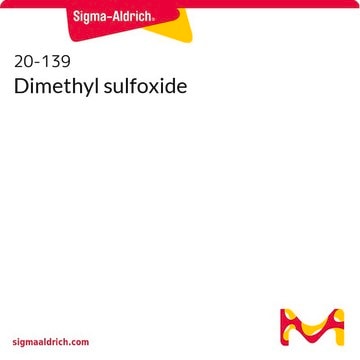Kluczowe dokumenty
W387509
Dimethyl sulfoxide
≥99%
Synonim(y):
DMSO
About This Item
Polecane produkty
pochodzenie biologiczne
synthetic
klasa czystości
Halal
agency
meets purity specifications of JECFA
gęstość pary
2.7 (vs air)
ciśnienie pary
0.42 mmHg ( 20 °C)
Próba
≥99%
temp. samozapłonu
573 °F
okres trwałości
Expiration date period - 5 years
granice wybuchowości
42 %, 63 °F
kolor
colorless
współczynnik refrakcji
n20/D 1.479 (lit.)
bp
189 °C (lit.)
189 °C
mp
16-19 °C (lit.)
rozpuszczalność
water: miscible
gęstość
1.10 g/mL (lit.)
Zastosowanie
flavors and fragrances
Dokumentacja
see Safety & Documentation for available documents
alergen pokarmowy
no known allergens
Organoleptyczne
butter; sulfurous
ciąg SMILES
CS(C)=O
InChI
1S/C2H6OS/c1-4(2)3/h1-2H3
Klucz InChI
IAZDPXIOMUYVGZ-UHFFFAOYSA-N
Szukasz podobnych produktów? Odwiedź Przewodnik dotyczący porównywania produktów
Opis ogólny
Zastosowanie
- α, β−Unsaturated carbonyl sugar derivatives.
- Conversion of secondary bromides or olefins to bromohydrin.
- Synthesis of α-hydroxycarbonyls from corresponding ketones.
Przestroga
Kod klasy składowania
10 - Combustible liquids
Klasa zagrożenia wodnego (WGK)
WGK 1
Temperatura zapłonu (°F)
188.6 °F - closed cup
Temperatura zapłonu (°C)
87 °C - closed cup
Środki ochrony indywidualnej
Eyeshields, Gloves, multi-purpose combination respirator cartridge (US)
Wybierz jedną z najnowszych wersji:
Masz już ten produkt?
Dokumenty związane z niedawno zakupionymi produktami zostały zamieszczone w Bibliotece dokumentów.
Klienci oglądali również te produkty
Nasz zespół naukowców ma doświadczenie we wszystkich obszarach badań, w tym w naukach przyrodniczych, materiałoznawstwie, syntezie chemicznej, chromatografii, analityce i wielu innych dziedzinach.
Skontaktuj się z zespołem ds. pomocy technicznej


